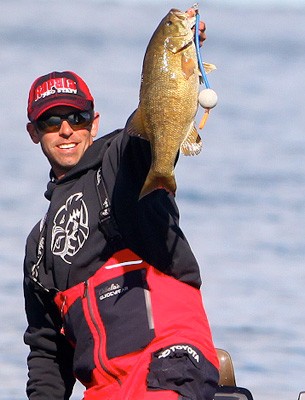
Editor’s Note: This is the seventh in a series profiling 2014 Elite Series locations.
Many Elite Series pros balked when they learned that the Delaware River was on the slate for August 7-10, 2014. The Delaware has long been highly industrialized, which is also true of the Ohio River.
Will the Delaware be as stingy as the Ohio River was during the 2005 Bassmaster Classic at Pittsburgh, Pa.?
“The Delaware River is going to surprise a lot of people,” Elite Series pro Michael Iaconelli says. “It’s a fantastic fishery.”
The Bassmaster Elite Series pros are no strangers to tidal rivers, but few of them have faced the dramatic tidal fluctuations that await them at the Delaware River. One of the few is New Jerseyan Iaconelli who has fished the Delaware for over 30 years.
“The average tidal swing on the Delaware River is 7 feet,” Iaconelli says. “The pros that tune into it will cull through 15 to 25 or more bass a day.”
That certainly wasn’t the case when Iaconelli was a youngster. Pollution had taken a toll on the Delaware River and its aquatic life. The Federal Clean Water Act of 1972 marked the beginning of the Delaware’s revitalization.
By the mid ‘80s, when Iaconelli began fishing the Delaware River for bass, it was much improved. Today, the water is clearer and full of life. Natural vegetation, including eel grass, spadderdock and lily pads, have returned. Lush milfoil and hydrilla beds also provide excellent bass habitat.
Green Bass or Brown?
Besides the Delaware’s enormous tidal fluctuations, another conundrum for the Elite pros will be whether to target largemouth or smallmouth bass. The largemouth comprise about 70 percent of the black bass population accessible to the pros during the tournament, Iaconelli points out. However, the smallmouth bass here tend to be heavier.
Smallmouth and largemouth bass coexist in parts of the Delaware River, but the brown bass are most prevalent in the tributaries between Philadelphia and Trenton. The water there is clearer than down river and has more rocky smallmouth habitat, Iaconelli asserts.
He adds that tournaments are won with smallmouth bass even farther upriver north of the Trenton Makes Bridge, which connects Trenton, N.J., to Morrisville, Pa. The downside here is that you court disaster.
“It gets rocky and treacherous up there and eventually turns into rapids,” Iaconelli says. “I’m sure some of the pros will chance it anyway.”
 It’s a good bet that some of the pros will chance it. During the Elite Series tournament at the Alabama River in May 2013, Jared Miller and other pros negotiated dangerous rapids to fish the tailwaters of the Jordan Dam. The rocks and swift smallmouth water of the Delaware River won’t keep them away.
It’s a good bet that some of the pros will chance it. During the Elite Series tournament at the Alabama River in May 2013, Jared Miller and other pros negotiated dangerous rapids to fish the tailwaters of the Jordan Dam. The rocks and swift smallmouth water of the Delaware River won’t keep them away.
The pros will catch largemouth to the south until the Delaware becomes too brackish for them. This is typically in the area of the Delaware Memorial Bridge. However, largemouth bass inhabit tributaries all the way down to Delaware Bay, Iaconelli explains. The bass will be caught from grassbeds and natural and man-made rock and wood cover, including bulkheads and docks.
“The pros will be able to fish a long stretch of good water on the Delaware,” Iaconelli says. “When you throw in the creeks, I think it will let the guys really spread out.”
Smorgasbord
Another twist with the Delaware River is the diversity of the bass forage. On many tournament waters, the bass have less to choose from. This simplifies bass movements and lure selection. For example, shad and bluegills are the primary forage on many reservoirs.
“Bass in the Delaware dine on shad, ocean run herring, eels, shore minnows, bluegills, white perch, yellow perch, crawfish, crabs and more,” Iaconelli says.
Most of the bass during the tournament will be caught from a skim of water to 10 feet deep by power fishing things like crankbaits and on soft plastic baits and jigs.
“What I’m most curious about is seeing if pros that have never fished the Delaware can find bass deeper,” Iaconelli says. “I have a friend who catches them 15 to 20 feet deep. That’s unusual here.”
Predictions
The Delaware teems with bass that weigh less than 2 pounds, Iaconelli claims. The key to finishing well here is to find bass that weigh over 2 pounds and to catch a bigger “kicker” bass each day.
“Anything much over 3 pounds is a kicker on the Delaware,” Iaconelli says. “You’ll need a bass that size or larger to anchor a good bag in August.”
Iaconelli predicts that it will take 11 to 12 pounds a day to make the top 50 cut. To finish among the top 12, and to possibly win, it will take 12 to 14 pounds a day.

